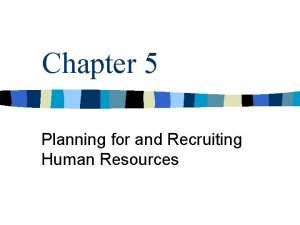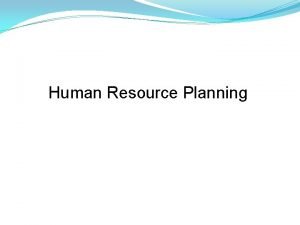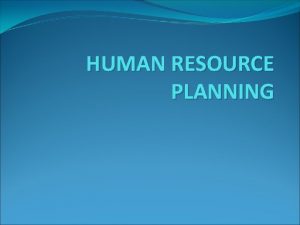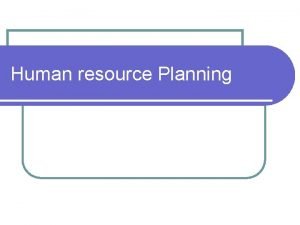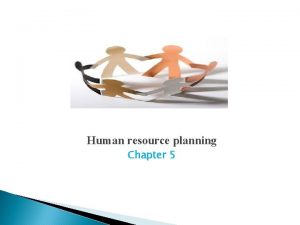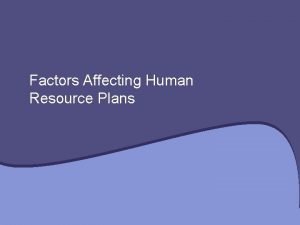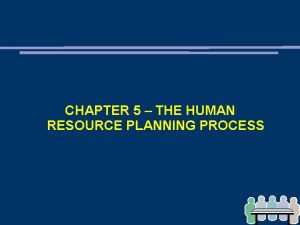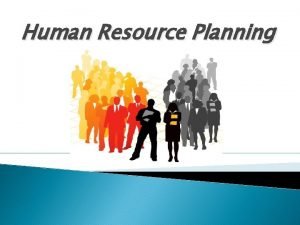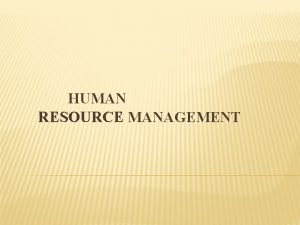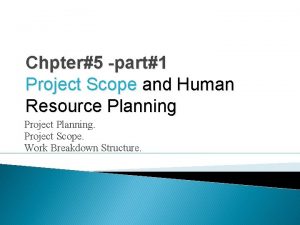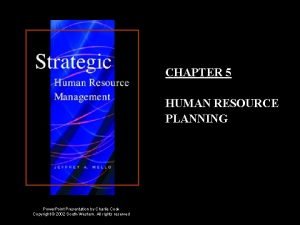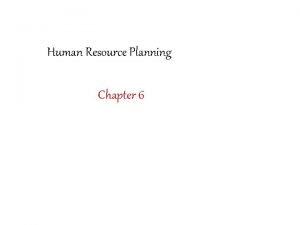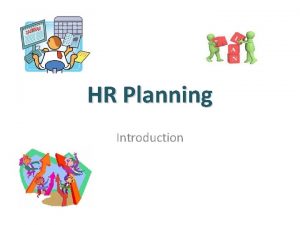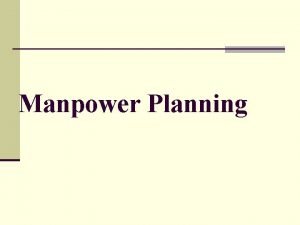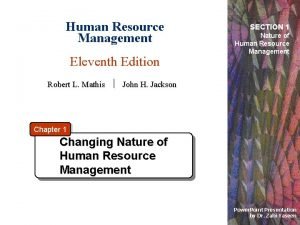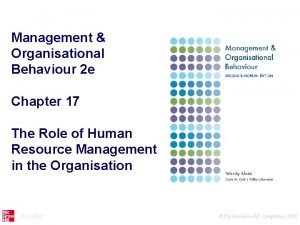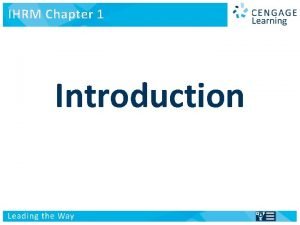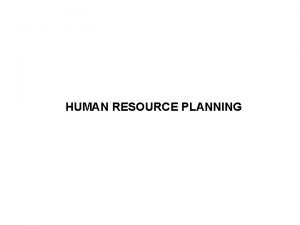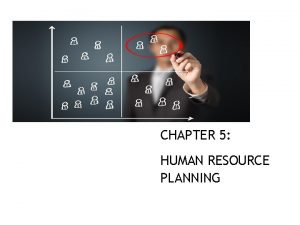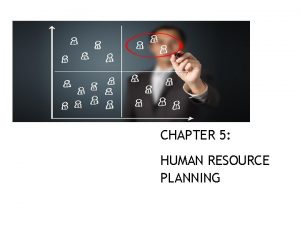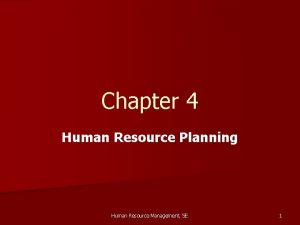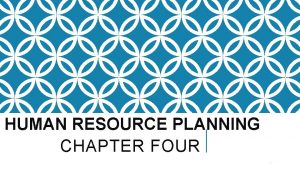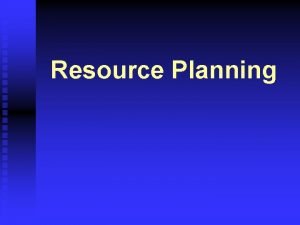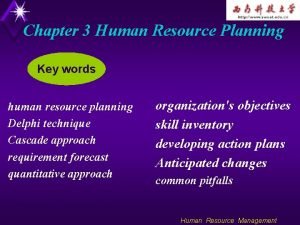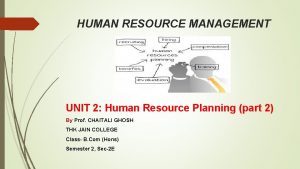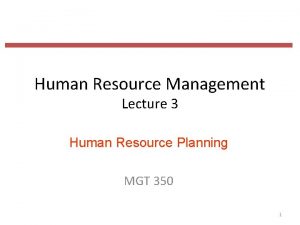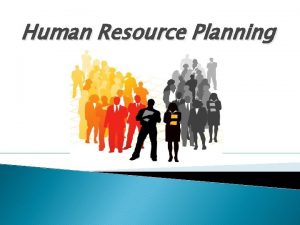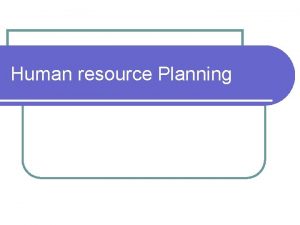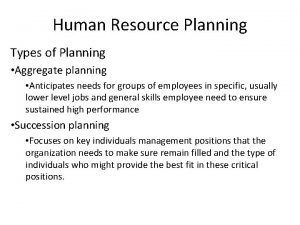CHAPTER 5 THE HUMAN RESOURCE PLANNING PROCESS KEY






















- Slides: 22

CHAPTER 5 – THE HUMAN RESOURCE PLANNING PROCESS

KEY CONCEPTS AND SKILLS ➲ ➲ ➲ Impact of business planning on human resource planning Long-term and short-term factors to be considered in human resource demand forecasting Factors to be considered in human resource supply forecasting Forecast human resource requirements based on production schedules Human resource actions needed to match human resources demand with supply Techniques used in human resource forecasting

CHAPTER OUTLINE Impact of business planning on human resource planning ➲ Determining human resource requirements ➲ Resources demand forecasting ➲ Resources supply forecasting ➲ Human resource actions ➲ Some human resource forecasting techniques ➲ Bottom-up approach ➲ Rule-of-thumb approach ➲ Zero-base forecasting ➲ The Delphi technique ➲ Time series or trend analysis ➲ Other forecasting methods ➲

HUMAN RESOURCE PLANNING ➲ Process of systematically reviewing human resource requirements so that organisation will be able to obtain the required number of employees with the required skills available at the time when needed.

IMPACT OF BUSINESS PLANNING ON HUMAN RESOURCE PLANNING ➲ ➲ Effective human resource planning can only be done after strategic planning Strategic Planning = organisation’s process of defining its strategy, or future direction, and making decisions on allocating its resources to pursue this strategy. Long-range strategic planning (2 to 5 years) flows into middle-range operational planning (1 to 2 years) From these plans, annual budgets are derived and budgeting decisions developed

Impact of Business Planning On Human Resource Planning BUSINESS PLANNING PROCESS HUMAN RESOURCE PLANNING PROCESS STRATEGIC PLANNING (Long-Term) Corporate Philosophy Environmental Scan Strengths and Weaknesses Objectives and Strategies ISSUES ANALYSIS Business Needs External Factors Internal Supply Analysis Implications for Management

Impact of Business Planning On Human Resource Planning BUSINESS PLANNING PROCESS HUMAN RESOURCE PLANNING PROCESS OPERATIONAL PLANNING (Medium-Term) Planned Programmes Resources Required Organisational Strategies Plans: Acquisitions Divestitures Net Requirements FORECASTING Staffing Levels Staffing Mix Organisation and Job Design Available and Projected Resources

Impact of Business Planning On Human Resource Planning BUSINESS PLANNING PROCESS HUMAN RESOURCE PLANNING PROCESS BUDGETING (Annual) Budgets Performance Goals Programmes Monitoring and Control of Results ACTION PLANS Staffing Authorisations Recruitment and Selection Promotions and Transfers Training and Development Compensation Industrial Relations

DETERMINING HUMAN RESOURCE REQUIREMENTS RESOURCES DEMAND FORECASTING Long-term Factors 1. The organisation’s long-term business plans. 2. Demographics. 3. The economy. 4. Technological trends. 5. Social trends.

RESOURCES DEMAND FORECASTING Short-term Factors 1. Production schedules and budgets. 2. Retrenchments or relocations of facilities.

RESOURCES SUPPLY FORECASTING 1. Current inventory. 2. Productivity level. 3. Turnover rate. 4. Absenteeism rate. 5. Movement among jobs.

HUMAN RESOURCE ACTIONS 1. Hiring. 2. Training. 3. Career management. 4. Productivity programmes. 5. Reductions in work force.

FORECASTING WORK FORCE REQUIREMENTS Step 1. Determine what department is scheduled to produce for period Step 2. Calculate how much work schedule means in terms of total man-hours Step 3. Convert totals to man-hours and divide by 8 to see how many man-days it will take to complete schedule Step 4. Divide total man-days by number of working days during period to find number of employees needed. Step 5. Check how many indirect persons are needed to service required number of employees during this period Step 6. Add number of direct labour to number of indirect persons to get total needed Step 7. Make allowances for absences.

SOME HUMAN RESOURCE FORECASTING TECHNIQUES Bottom-Up Approach ➲ Using supervisor and manager estimates of manpower requirements ➲ Based on reasoning that people at the bottom where the action is (supervisors and managers) are most knowledgeable about employment requirements. ➲ Good method especially in making short-term forecasts. ➲ Each successive level, starting with the lowest, forecasts its requirements, ultimately providing a total forecast of employees needed.

SOME HUMAN RESOURCE FORECASTING TECHNIQUES Rule-Of-Thumb Approach ➲ Rules of thumb set up for certain environmental conditions that are used forecasting human resource requirements ➲ E. g. , a department store may choose to hire a new sales assistant for each 100 square metres of floor space ➲ Rule-of-thumb technique is useful but main disadvantage is that the rules of thumb are designed to maintain the status quo.

SOME HUMAN RESOURCE FORECASTING TECHNIQUES Zero-Base Forecasting ➲ ➲ ➲ ➲ Based on techniques of zero-base budgeting Does not use organisation’s current level of staffing as starting point for determining future staff requirements Each annual budget must be re-justified and managers will need to defend with supporting evidence why they need so many people in their department When a position becomes vacant, vacancy not filled automatically Instead, manager will have to justify why the position needs to be filled Any new positions must also be justified accordingly. Through zero-base forecasting, organisation ensures no over-staffing takes place.

SOME HUMAN RESOURCE FORECASTING TECHNIQUES The Delphi Technique ➲ ➲ ➲ ➲ Structured approach for reaching consensus judgement Experts chosen on basis of knowledge of internal factors, general business plans, or external factors that might affect demand Objective is to predict future developments in particular area by integrating independent opinions of experts. Face-to-face group discussion among experts avoided Intermediary is used Intermediary’s job to pool, summarise, and feedback to experts during first round of forecasting Cycle then repeated, so that experts given opportunity to revise their forecasts and reasons behind their opinion within three to five rounds.

SOME HUMAN RESOURCE FORECASTING TECHNIQUES Time Series or Trend Analysis ➲ Quantitative method that makes use of trend extrapolation by using past trends to make projections into the future. 1. Find appropriate business factor ➲ Critical first step is to select a business factor to which workforce size can be related ➲ Business factor must satisfy 2 requirements: ➲ should relate directly to essential nature of business ➲ changes in selected factor must be proportional to number of employees required

SOME HUMAN RESOURCE FORECASTING TECHNIQUES Time Series or Trend Analysis 2. Plot historical relationship between business factor and work force size ➲ Develop quantitative relationship between past staffing levels and past levels of the business factor. 3. Labour productivity ➲ Ratio of output per individual worker ➲ To forecast staffing requirements accurately, necessary to know rate at which labour productivity and business factor are changing.

SOME HUMAN RESOURCE FORECASTING TECHNIQUES Time Series or Trend Analysis 4. Determining the trend in labour productivity and adjustments to the trend ➲ To determine average annual rate of productivity change during past 5 or 10 years, data must be collected ➲ Can calculate average annual productivity change and, along with projected changes in business factor, use as forecast of what changes will be forthcoming ➲ Evaluate causes of any past changes deviating from average annual change in productivity.

SOME HUMAN RESOURCE FORECASTING TECHNIQUES Time Series or Trend Analysis 5. Projecting future staffing needs to the target year ➲ Projection of staff needs to target year is straightforward ➲ Actual and projected levels of the business factor and actual and projected labour productivity obtained ➲ Number needed in any given year can be determined ➲ Forecast of net HR demand is determined simply by subtracting the supply forecast from the demand forecast.

SOME HUMAN RESOURCE FORECASTING TECHNIQUES Other Forecasting Methods ➲ Budget and planning analysis
 Chapter 5 planning for and recruiting human resources
Chapter 5 planning for and recruiting human resources Forecasting techniques in hrm
Forecasting techniques in hrm Short term hr planning
Short term hr planning Human resource planning
Human resource planning Hrp meaning and definition
Hrp meaning and definition Resource forecasting meaning
Resource forecasting meaning 5 stages of human resource planning
5 stages of human resource planning Human resource management question papers
Human resource management question papers Social factors affecting human resource management
Social factors affecting human resource management Supply forecasting techniques in hrp
Supply forecasting techniques in hrp Purpose of induction
Purpose of induction Swot analysis of hr department
Swot analysis of hr department Resource planning definition
Resource planning definition Scope of human resource planning
Scope of human resource planning Human resource planning model ppt
Human resource planning model ppt Hr planning meaning
Hr planning meaning Hr definition
Hr definition E.w. vetter
E.w. vetter Human resource management is in nature
Human resource management is in nature Markov analysis human resources
Markov analysis human resources Human resource planning steps
Human resource planning steps Domestic and international human resource management
Domestic and international human resource management Importance of human resource planning
Importance of human resource planning
